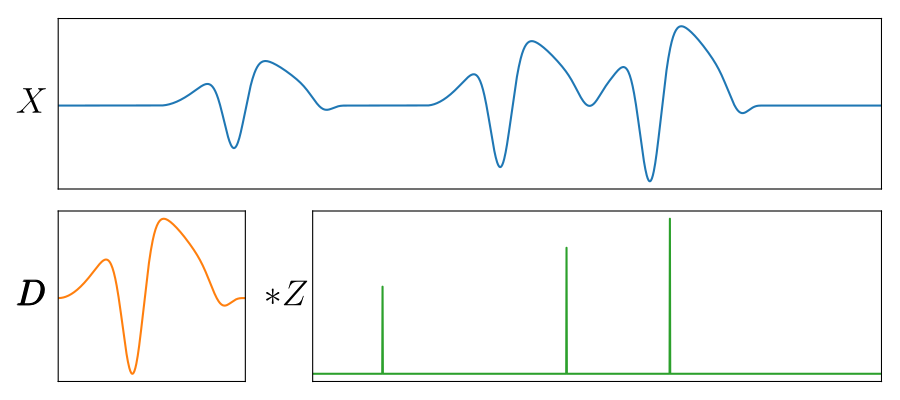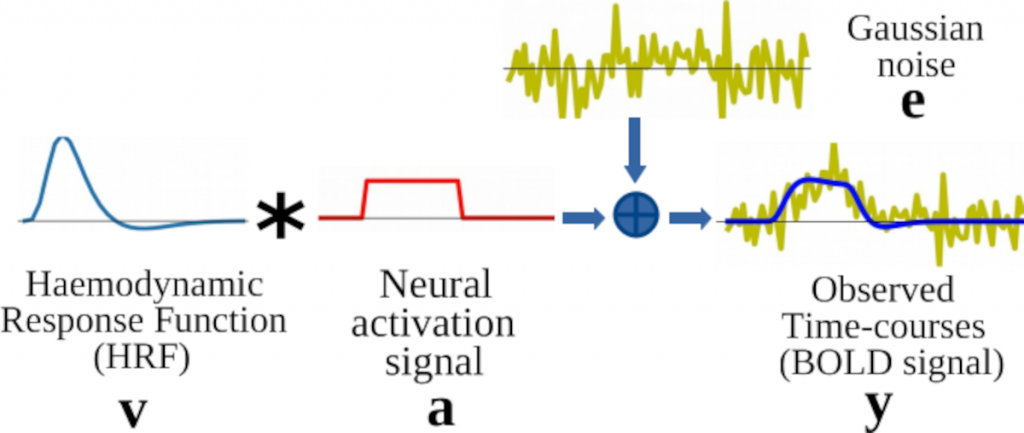Convolutional dictionary Learning in neuroscience
Neural time-series data contain a wide variety of prototypical signal waveforms that are of significant importance in clinical and cognitive research [1-2]. One of the goals of analyzing such data is hence to extract recurring and “shift-invariant” patterns from the data. Fourier and Morlet methods which are quite often used to analyze such signals can distort the shape. This may lead to a “Fourier fallacy” [3] as one may assume ad hoc that the sinusoidal frequencies represent actual phenomena in cell groups within the brain. Here, we deal with this issue by developing convolutional sparse coding (CSC) models dedicated to neural
signals.
Convolutional Dictionary Learning : Convolutional dictionary learning (CDL) estimates shift invariant basis adapted to represent some signals or images. It was first developed by [5] for music recognition and has then been used extensively for denoising and inpainting of images [4,6]. Beyond denoising or inpainting, recent applications used this shift-invariant model as a way to learn and localize important patterns in signals or images [7]. This technique can be used to extract recurring patterns in neurological activity recordings. for a signal X, the model decompose a signal as a convolution between sparse signals Z encoding the localization of patterns D capturing the local variations.

Convolutional Dictionary Model
References
[1] Cole, S. R. & Voytek, B. Brain Oscillations and the Importance of Waveform Shape. Trends in Cognitive Sciences 21, 137–149 (2017).
[2] Jones, S. R. When brain rhythms aren’t ‘rhythmic’: implication for their mechanisms and meaning. Current Opinion in Neurobiology 40, 72–80 (2016).
[3] Jasper, H. H. Charting the Sea of Brain Waves. Science 108, 343–347 (1948).
[4] Bristow, H., Eriksson, A. & Lucey, S. Fast convolutional sparse coding. in CVPR 391–398 (2013).
[5] Grosse, R., Raina, R., Kwong, H. & Ng, A. Y. Shift-Invariant Sparse Coding for Audio Classification. in UAI (2007).
[6] Kavukcuoglu, K., Sermanet, P., Boureau, Y., Gregor, K. & Le Cun, Y. Learning Convolutional Feature Hierarchies for Visual Recognition. in NeurIPS 1090–1098 (2010).
[7] Yellin, F., Haeffele, B. D. & Vidal, R. Blood cell detection and counting in holographic lens-free imaging by convolutional sparse dictionary learning and coding. in ISBI (2017).
Multivariate Convolutional Sparse Coding for Electromagnetic Brain Signals
Frequency-specific patterns of neural activity are traditionally interpreted as sustained rhythmic oscillations, and related to cognitive mechanisms such as attention, high level visual processing or motor control. While alpha waves (8–12\,Hz) are known to closely resemble short sinusoids, and thus are revealed by Fourier analysis or wavelet transforms, there is an evolving debate that electromagnetic neural signals are composed of more complex waveforms that cannot be analyzed by linear filters and traditional signal representations.
We propose to learn dedicated representations of such recordings using a multivariate convolutional sparse coding (CSC) algorithm with rank-1 constraints. Applied to electroencephalography (EEG) or magnetoencephalography (MEG) data, this method is able to learn not only prototypical temporal waveforms, but also associated spatial patterns so their origin can be localized in the brain. Our algorithm is based on alternated minimization and a greedy coordinate descent solver that leads to state-of-the-art running time on long time series. To demonstrate the implications of this method, we apply it to MEG data and show that it is able to recover biological artifacts. More remarkably, our approach also reveals the presence of non-sinusoidal mu-shaped patterns, along with their topographic maps related to the somatosensory cortex.

Patterns Learned through rank-1 CDL for an auditory and visual stimulation.
Code
A python package is available at https://alphacsc.github.io
References
Dupré la Tour, T., Moreau, T., Jas, M. & Gramfort, A.
Multivariate Convolutional Sparse Coding for Electromagnetic Brain Signals.
Advances in Neural Information Processing Systems (NeurIPS) 3296–3306 (2018).
Jas, M., Dupré la Tour, T., Şimşekli, U. & Gramfort, A.
Learning the Morphology of Brain Signals Using Alpha-Stable Convolutional Sparse Coding.
Advances in Neural Information Processing Sytems (NeurIPS) 1099–1108 (2017).
Distributed Convolutional Dictionary Learning (Dicodile)
As estimated patterns can be positioned anywhere in signals or images, optimization techniques face the difficulty of working in extremely high dimensions with millions of pixels or time samples, contrarily to standard patch-based dictionary learning. To address this optimization problem, we proposed a distributed and asynchronous algorithm, employing locally greedy coordinate descent and an asynchronous locking mechanism that does not require a central server called Dicodile. This algorithm can be used to distribute the computation on a number of workers which scales linearly with the encoded signal’s size. Experiments confirm the scaling properties which allows us to learn patterns on large scales images from the Hubble Space Telescope.

Communication process in Dicodile for two cores.
Code
A python package is available at https://github.com/tomMoral/dicodile
References
Moreau, T. & Gramfort, A.
preprint ArXiv 1901.09235, (2019).
Moreau, T., Oudre, L. & Vayatis, N.
International Conference on Machine Learning (ICML) 3626–3634 (2018).
HRF estimation using Convolutional Model
In the context of BOLD signals — acquired in fMRI recordings — one may want to estimate the Hemodynamic Response Function (HRF). Here, the related activation signal is not expected to be sparse anymore but can be modeled as a block signal — i.e. a piecewise constant signal. The general model for one voxel can then be described as
 To estimate the parameters of such model, one can use TV-regularized problems which promotes the bloc structure in the activations. The global optimization technique also relies on alternate minimization and proximal gradient descent but with a modified proximal operator.
To estimate the parameters of such model, one can use TV-regularized problems which promotes the bloc structure in the activations. The global optimization technique also relies on alternate minimization and proximal gradient descent but with a modified proximal operator.
More information on the adaptation of this approach in the context on HRF estimation is available here .
Code
A python package is available at https://github.com/hcherkaoui/hemolearn
References
Cherkaoui, H., Moreau, T., Halimi, A. & Ciuciu, P.
European Signal Processing Conference (EUSIPCO) (2019).
Cherkaoui, H., Moreau, T., Halimi, A. & Ciuciu, P.
IEEE International Conference on Acoustics, Speech and Signal Processing (ICASSP) (2019).

 To estimate the parameters of such model, one can use TV-regularized problems which promotes the bloc structure in the activations. The global optimization technique also relies on alternate minimization and proximal gradient descent but with a modified proximal operator.
To estimate the parameters of such model, one can use TV-regularized problems which promotes the bloc structure in the activations. The global optimization technique also relies on alternate minimization and proximal gradient descent but with a modified proximal operator.


